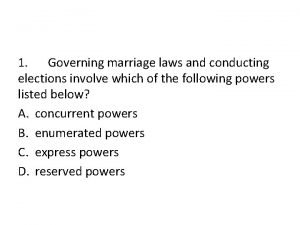CONDUCTING A DISCUSSION How to Conduct a Discussion
















- Slides: 16

CONDUCTING A DISCUSSION

How to Conduct a Discussion Ø You may have to lead a discussion as part of student assignment or you may be responsible for leading a discussion in a work setting. Ø An effective discussion will involve all participants, so make sure to draw out everyone's opinion by encouraging participants to share. Ø Welcome new topics as they come up but be sure to direct the discussion toward some kind of conclusion. Ø With a little know how and by being perceptive and proactive you can lead a great group discussion.

1: -Beginning the Discussion Allow everyone to introduce themselves To start a discussion, make sure everyone is comfortable. A good way to break the ice is to let everyone introduce themselves. This way, you'll go into the discussion with everyone knowing everyone else a little bit. o You can go around the room and have everyone say their name. o You may want each person to explain why they're participating in the discussion. o For a classroom setting, an icebreaker activity may work well. o You could, for example, have everyone share their favorite personalities etc.

Establish some ground rules Before launching into the discussion, make sure everyone knows the rules of conduct. Advise everyone to treat one another with respect. Make it clear there should be no name-calling, personal attacks, or vulgarity. You can argue with someone's idea or opinion, but cannot argue with that person on a personal level. Remind everyone to be aware of time, and to make their points concisely so everyone has the chance to share. Encourage people to consider their comments seriously, and to avoid becoming defensive if someone disagrees.

Explain the topic Usually, Even a discussion will be based around a central topic. if the participants know what topic is, give them a quick refresher before the discussion begins. You can introduce the topic by asking questions. For example, say something like, "Why are we all here? " This can be helpful if you're managing a conflict, or making plans for an event that are uncertain. You can also quickly introduce the idea. Say something like, "As you know, today we're going to discuss …. . . "

Ask open-ended questions to begin You do not want to ask questions with a simple "yes" or "no" answer, especially not initially. Opening questions should not have a right or wrong answer, as this will push people to begin the discussion. o Your questions should encourage people to share meaningful thoughts and ideas. o Questions can be confusing to the participants. o Many participants may not know the answers right, encourage them to think during discussion. o For example, "What is it about our culture that contributes to adoption of innovation? " This question is complicated, and have many potential answers.

3: -Facilitating an Open Conversation Push towards new ideas when necessary You can help move the discussion forward by introducing new ideas. o You want to make sure the discussion does not stay too long on one topic, so if you're lingering on one talking point, see what new ideas are being generated. o When you hear a new potential idea, you can encourage the group to discuss this. o For example, one participant brings up the second idea during the discussion. o You have yet to really discuss the history and implications of that idea. o You can say something like, "Hey, I think Mr. /Ms. made a great point. What about the second idea?

Ask participants follow-up questions At first, people may give surface level answers to questions. If this is a problem, encourage people to open up more. After someone shares, ask a follow up question to encourage them to pick apart their opinion. o Follow up questions should usually be ambiguous o For example, you can say something like, "Really? What makes you think that? " You can also say, "How do you feel about that fact? " o Watch your tone. You want to sound friendly and inquisitive rather than authoritarian. If delivered in a harsh tone, "What makes you think that? " can sound like you disagree. When delivered in a light tone, you simply come off like you're curious to find new information.

Encourage everyone to participate Group discussions work well if everyone shares. Some participants may be hesitant to open up, so work on creating an environment where everyone feels comfortable sharing. o Breaking up into small groups for a moment can encourage more participation. o You can tell the group to discuss the issue with the person next to them for 5 minutes. o Then, you can re-assemble and ask everyone to share the discussions they had. o You should also make it clear that everyone's opinion matters. Write everyone's comment on a white board. If a participant made a good point awhile ago, but has been silent for a bit, return to his or her point to move the discussion forward.

Move the discussion forward as needed Usually, you will have some kind of agenda for a group discussion. You want participants to reach some kind of conclusion, agreement, or insight. As the discussion continues, work to move it towards a conclusion. o Keep asking questions throughout the discussion. o For example, "While we all disagree on what the policy means, how much does that matter? " Push participants for clarification. Getting more insight out of an opinion can help introduce new ideas, leading to new insight for the discussion. For example, "I understand you feel effective policy would decrease farming problems, but can you tell me more about what makes you feel that way? "

Wrap up the discussion You should review the discussion briefly when it reaches its end. What has everyone learned? Have you reached any conclusions? o Make sure everyone understands the key points made. o You can say something like, "I'm hearing half of you feel that policy is important for agriculture development, while half of you feel there should be subsidized inputs. ” Ask open ended questions that will lead the group to reflect on what everyone learned. For example, "Have your opinions on policy or subsidy changed? Leaving this session, how do you think you'll discuss the issue in the future? "

4: - Handling Problems Avoid letting one person or group dominate Oftentimes, you get a mixed group. Some people are shy and withdrawn, while others are not. Some members can dominate a discussion, and you want to make sure everyone gets a chance to share. o If one group has been bringing up the same point for awhile, try to cut it off in a respectful manner. For example, "I think those issues are important, but I want to make sure we give time to other factors surrounding this debate. " o Try to bring the discussion back to the shy people. For example, “Mr. /Ms…. . made up an interesting point earlier. Maybe we could revisit that. ”

Deal with a participant who talks too much Sometimes, it is a single person who is very assertive and tends to dominate the conversation. Even if this person is making good points, it's important you not let a single person dominate. o Try asking the talkative person to act as an observer for a few minutes. For example, "John, you seem to have strong opinions. Why don't you just observe for a few minutes. Take notes on the discussion. You can share these later, and we can see how the discussion shaped your opinions. " o You can also try to use the dominant person's input to conduct the conversation in a new direction.

Smooth over conflict If you're dealing with a sensitive subject especially, people may get angry. If a conversation starts to become confrontational or tense, find ways to break up the tension. o Ask people arguing to back up their opinions using outside authority. This will cause the discussion to become more objective and less personal. o Ask people to be aware of differences in values. o Say something like, "I feel like the two of you share different values. Can we talk about that? " o You can also list both sides of the argument on the board. Encourage participants to continue to debate the point, but in a respectful manner. o Say something like, "I think we should talk about this, as we all feel strongly, but let's take turns examining each other's points respectfully. ”

Help shy participants share their opinions Sometimes, the smartest participants are the most shy. You want to make sure those who feel uncomfortable sharing do so. It's important to hear everyone's thoughts. o You can ask the shy participant directly. For example, ”Mr/Ms…. . . , why don't you tell us how you feel? " You can also have everyone write down their answers to a question and then share. A nervous participant may feel more comfortable sharing if they have their idea written down.

For more detail: https: //www. wikihow. com/Conduct-a-Group-Discussion#/Image: Conduct-a-Group-Discussion-Step 13. jpg http: //ctb. ku. edu/en/table-of-contents/leadership/group-facilitation/group-discussions/main http: //www. smallgroups. com/articles/2008/tips-for-facilitating-group-discussion. html? paging=off https: //www. lds. org/ensign/2016/02/conducting-a-well-tuned-group-discussion? lang=eng http: //ctb. ku. edu/en/table-of-contents/leadership/group-facilitation/group-discussions/main
 Conduct focus group discussion
Conduct focus group discussion Fractional distillation discussion
Fractional distillation discussion When conducting research online the keyword
When conducting research online the keyword Statistics is the science of conducting studies to
Statistics is the science of conducting studies to Line regulation formula
Line regulation formula What is survey experiment or observation?
What is survey experiment or observation? Six identical conducting rods
Six identical conducting rods Chapter 29 conducting marketing research answers
Chapter 29 conducting marketing research answers Conducting effective meetings ppt
Conducting effective meetings ppt The nurse is conducting developmental surveillance
The nurse is conducting developmental surveillance Electric potential inside non conducting sphere
Electric potential inside non conducting sphere Governing marriage laws and conducting elections
Governing marriage laws and conducting elections A square conductor moves through a uniform
A square conductor moves through a uniform Minute ventilation normal
Minute ventilation normal Internal audit assurance engagement
Internal audit assurance engagement Conducting business ethically and responsibly
Conducting business ethically and responsibly What is a fair test in science
What is a fair test in science































